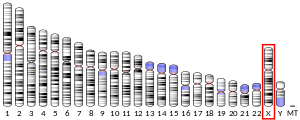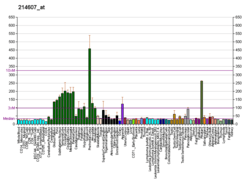PAK3
PAK3 (p21-activated kinase 2, beta-PAK) is one of three members of Group I PAK family of evolutionary conserved serine/threonine kinases.[5][6][7] PAK3 is preferentially expressed in neuronal cells [8][9] and involved in synapse formation and plasticity and mental retardation.[10][11]
Discovery
PAK3 was initially cloned from a murine fibroblast cDNA library and from a murine embryo cDNA library.[8][9] Like other group I PAKs, PAK3 is stimulated by activated Cdc42 and Rac1.
Gene and spliced variants
The human PAK3 gene, the longest group I family member, is 283-kb long. The PAK3 gene is composed of 22 exons of which 6 exons are for 5’-UTR and generates 13 alternative spliced transcripts. Among PAK3 transcripts, 11 transcripts are for coding proteins ranging from 181- to 580-amino acids long, while remaining two transcripts are non-coding RNAs.[12] The murine PAK3 gene contains 10 transcripts, coding six proteins from 544 amino acids and 559 amino acids long, and four smaller polypeptides from 23 to 366 amino acids.
Protein domains
Similar to PAK1, PAK2 contains a p21-binding domain (PBD) and an auto-inhibitory domain (AID) and exists in an inactive conformation.[13]
Activators and inhibitors
PAK3 activity is stimulated by Dbl, Cdc42 and Cool-2,[14][15] and by AP1 transcription factor.[16] Stimulation of PAK3 activity by upstream stimulators such as Dbl or Cdc42 is inhibited by p50 (Cool-1)[15] PAK3 activity is inhibited by FRAX597, a PAN inhibitor of PAKs.[17]
Functions
PAK3 is overexpressed in neuroendocrine/carcinoids tumors.[18] PAK3 has been shown to be important for synapse formation and plasticity, and contribute to mental retardation.[10] Further, a point mutation in PAK3 gene has been associated with nonsyndromic X-linked mental retardation.[11]
Notes
References
- GRCh38: Ensembl release 89: ENSG00000077264 - Ensembl, May 2017
- GRCm38: Ensembl release 89: ENSMUSG00000031284 - Ensembl, May 2017
- "Human PubMed Reference:". National Center for Biotechnology Information, U.S. National Library of Medicine.
- "Mouse PubMed Reference:". National Center for Biotechnology Information, U.S. National Library of Medicine.
- Knaus UG, Morris S, Dong HJ, Chernoff J, Bokoch GM (July 1995). "Regulation of human leukocyte p21-activated kinases through G protein--coupled receptors". Science. 269 (5221): 221–3. doi:10.1126/science.7618083. PMID 7618083.
- Manser E, Chong C, Zhao ZS, Leung T, Michael G, Hall C, Lim L (October 1995). "Molecular cloning of a new member of the p21-Cdc42/Rac-activated kinase (PAK) family". The Journal of Biological Chemistry. 270 (42): 25070–8. doi:10.1074/jbc.270.42.25070. PMID 7559638.
- Kumar A, Molli PR, Pakala SB, Bui Nguyen TM, Rayala SK, Kumar R (July 2009). "PAK thread from amoeba to mammals". Journal of Cellular Biochemistry. 107 (4): 579–85. doi:10.1002/jcb.22159. PMC 2718766. PMID 19350548.
- Bagrodia S, Taylor SJ, Creasy CL, Chernoff J, Cerione RA (September 1995). "Identification of a mouse p21Cdc42/Rac activated kinase". The Journal of Biological Chemistry. 270 (39): 22731–7. doi:10.1074/jbc.270.39.22731. PMID 7559398.
- Burbelo PD, Kozak CA, Finegold AA, Hall A, Pirone DM (May 1999). "Cloning, central nervous system expression and chromosomal mapping of the mouse PAK-1 and PAK-3 genes". Gene. 232 (2): 209–15. doi:10.1016/s0378-1119(99)00110-9. PMID 10352232.
- Boda B, Alberi S, Nikonenko I, Node-Langlois R, Jourdain P, Moosmayer M, Parisi-Jourdain L, Muller D (December 2004). "The mental retardation protein PAK3 contributes to synapse formation and plasticity in hippocampus". The Journal of Neuroscience. 24 (48): 10816–25. doi:10.1523/jneurosci.2931-04.2004. PMC 6730202. PMID 15574732.
- Allen KM, Gleeson JG, Bagrodia S, Partington MW, MacMillan JC, Cerione RA, Mulley JC, Walsh CA (September 1998). "PAK3 mutation in nonsyndromic X-linked mental retardation". Nature Genetics. 20 (1): 25–30. doi:10.1038/1675. PMID 9731525.
- Kreis P, Rousseau V, Thévenot E, Combeau G, Barnier JV (August 2008). "The four mammalian splice variants encoded by the p21-activated kinase 3 gene have different biological properties". Journal of Neurochemistry. 106 (3): 1184–97. doi:10.1111/j.1471-4159.2008.05474.x. PMID 18507705.
- Kumar R, Li DQ (2016). PAKs in Human Cancer Progression: From Inception to Cancer Therapeutic to Future Oncobiology. Advances in Cancer Research. 130. pp. 137–209. doi:10.1016/bs.acr.2016.01.002. ISBN 9780128047897. PMID 27037753.
- Bagrodia S, Bailey D, Lenard Z, Hart M, Guan JL, Premont RT, Taylor SJ, Cerione RA (August 1999). "A tyrosine-phosphorylated protein that binds to an important regulatory region on the cool family of p21-activated kinase-binding proteins". The Journal of Biological Chemistry. 274 (32): 22393–400. doi:10.1074/jbc.274.32.22393. PMID 10428811.
- Bagrodia S, Taylor SJ, Jordon KA, Van Aelst L, Cerione RA (September 1998). "A novel regulator of p21-activated kinases". The Journal of Biological Chemistry. 273 (37): 23633–6. doi:10.1074/jbc.273.37.23633. PMID 9726964.
- Holderness Parker N, Donninger H, Birrer MJ, Leaner VD (2013). "p21-activated kinase 3 (PAK3) is an AP-1 regulated gene contributing to actin organisation and migration of transformed fibroblasts". PLOS ONE. 8 (6): e66892. doi:10.1371/journal.pone.0066892. PMC 3688571. PMID 23818969.
- Licciulli S, Maksimoska J, Zhou C, Troutman S, Kota S, Liu Q, Duron S, Campbell D, Chernoff J, Field J, Marmorstein R, Kissil JL (October 2013). "FRAX597, a small molecule inhibitor of the p21-activated kinases, inhibits tumorigenesis of neurofibromatosis type 2 (NF2)-associated Schwannomas". The Journal of Biological Chemistry. 288 (40): 29105–14. doi:10.1074/jbc.m113.510933. PMC 3790009. PMID 23960073.
- Liu RX, Wang WQ, Ye L, Bi YF, Fang H, Cui B, Zhou WW, Dai M, Zhang J, Li XY, Ning G (August 2010). "p21-activated kinase 3 is overexpressed in thymic neuroendocrine tumors (carcinoids) with ectopic ACTH syndrome and participates in cell migration". Endocrine. 38 (1): 38–47. doi:10.1007/s12020-010-9324-6. PMID 20960100.





